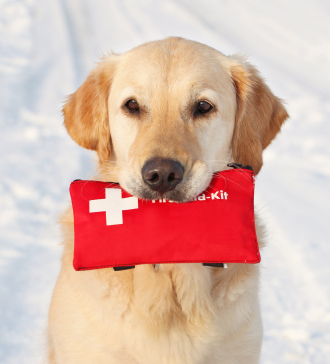Hurricanes, floods, tornados and earthquakes can strike a home at any time. It can be stressful enough figuring out what you will do and where you will go when disaster strikes. What happens to your dog? In an emergency situation, there is often little time to devise a plan. Thinking ahead can make things much easier and safer for you and your dog.
Get a rescue alert sticker
This sticker is placed on a house window, and it informs anyone who is near your home that you have pets inside. This can be especially useful in situations such as floods or fires. The sticker allows you to include information about the types of pets you own and how many. It also has space to include contact information for your dog’s vet. You can purchase stickers at a local pet store or get a free rescue pack from the ASPCA, which includes a sticker, online here.
Evacuations
If a flood or tornado nears your home, you will likely be warned to evacuate. If this happens, do not simply leave your dog at home. It could be days or even weeks before you are allowed back home and by then, your dog will likely have either died from hunger or run off to find you.
Instead, take your dog with you. Many evacuation shelters do not allow dogs, so you will have to plan in advance. You may need to look for hotels that allow pets. You should also check with your vet or a boarding facility to see if they can care for your pet.
You should make sure your dog is properly identified. He should be wearing a collar with an ID tag that clearly shows his name and our contact information. It is recommended that he be microchipped as well in case he wanders off.
Climate considerations
Some areas of the country are more prone to extreme weather conditions, such as hurricanes and floods. Therefore, you should expect the worst and have a disaster plan in place. The plan should include:
- Where to go in case disaster strikes. There should be a safe room in your home without windows or risk of debris. This could be a bathroom, pantry, basement or closet. Keep your dog in the home with you. Try to stay calm, as dogs can sense stress from their human owners. If your dog is feeling uneasy, you may want to keep her in a crate or small kennel. Whatever you do, do not keep dogs outside. If they are left outside, they are to unsafe conditions and may run away in search for safety.
- How you will access clean water. You may want to keep bottled water in your safe area. You should also consider filling up bathtubs and sinks with water so you have some in case you lose electricity.
- Where you will go if it starts flooding. You should be near high shelves and counters so your dog can access them if the water gets too high.
Choosing caregivers
 Preparing Your Dog for Disasters Emergency situations can, unfortunately, result in you becoming severely injured, disabled or even dead. You should choose temporary and permanent caregivers ahead of time so you can be sure that your pet will be properly cared for if you are not able to do so. If you do not choose a caregiver and something happens to you, your dog may be taken to an animal shelter and euthanized.
Preparing Your Dog for Disasters Emergency situations can, unfortunately, result in you becoming severely injured, disabled or even dead. You should choose temporary and permanent caregivers ahead of time so you can be sure that your pet will be properly cared for if you are not able to do so. If you do not choose a caregiver and something happens to you, your dog may be taken to an animal shelter and euthanized.
Choosing the right person to act as your dog’s caregiver requires some careful planning. The person should ideally be a neighbor or someone who lives fairly close by. This person could be a friend or family member. In any case, it should be someone who has experience caring for animals.
Whoever you choose, be sure that the person has access to your home. You should provide this person with a set of keys to your home so he or she can check on your dog easily. You should provide the caregivers with detailed instructions about how to care for your dog, including feeding schedules, type of food, favorite activities and medications, if needed.
Emergency kit
An emergency kit can help your dog get through emergencies and possibly save his life. You should have a kit ready to go that contains that following:
- Enough food, water and medication to last your dog at least one week
- Food bowls
- First aid supplies, such as bandages, gauze, tape and iodine
- A leash for each dog
- Dog toys and beds
- Cleaning supplies, such as plastic bags, paper towels and either a bar of soap or a small bottle of dish soap
- A travel dog carrier
- Towels and blankets
- Your dog’s veterinary records/proof of immunizations
- A current photo of your dog
- Phone numbers for the vet, local hotels and boarding facilities
- Flashlights and extra batteries

Leave a Reply